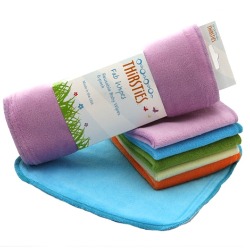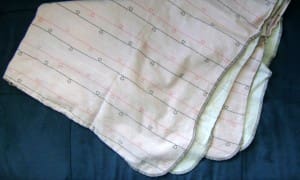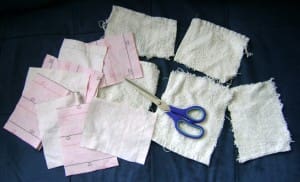Welcome to my series on Cloth Diapers. If you missed the previous entries, you can start reading here. Today’s post is brought to you by Yosefa in Israel, who shares how homemade wipes can be simple, frugal and healthy.
Last month, I sent a frantic e-mail to my dermatologist friend with the subject, “WARNING: Picture of baby’s red rear.”
It was not the kind of image you want to see on your screen, nor in your loved one’s diaper. Dr. Danny said to quit using baby wipes.
I realized that with all the discussion of cloth diapers, many of us forget about wipes. For some, it is obvious. Stick that cute bum under the faucet; no wiping required.
Most of us appreciate the convenience of disposable wet wipes. But, using cloth wipes is just as easy.
You may find that even day care providers are willing to make the switch. My baby’s teacher doesn’t mind sending them home for me to wash.
As for washing them, cloth wipes take up so little space in the laundry, it is almost a non-issue. That said, the benefit for your baby’s bottom is the best argument to use cloth wipes. I still use disposable wipes when I go out, as long as my baby doesn’t have a rash. But her rear end has never looked better!
Making wipes
To make wipes, find rags, one or two flannel receiving blankets, or tee-shirts ready for the scrap pile. You can get 25 bar towels from Costco for $13-$16, or a pack of 4 flannel blankets from Target for $7.99.
I use the rags from Costco in my kitchen instead of paper towels, so I had several ready to be cut up. However, the flannel blankets come in really cute designs, are easier to cut, and will probably fray less.
I cut the rags into 6 pieces each, and I cut a large (about 42” square) receiving blanket into 40 pieces. I am not concerned with frayed, stringy edges. You can see in the picture what the cut rags look like after several washes (the rags had already been washed a couple times a week for over a year).
If frayed edges concern you, run a zig-zag stitch around the edges of each rag, or cut with pinking shears (zig-zag scissors). Personally, I prefer not to invest much time or money in wiping poo.
Cut the wipes large enough to keep your hands clean, but small enough so you won’t be tempted to “double dip.” When the rags are ready to be retired, put them in your diaper bag and use them when you’re out, then throw them away.
When traveling, you have two options: Keep the clean, wet rags in a zip-top bag, or pack dry cloths and count on access to water.
At home, find the set-up that is most comfortable for you. I keep a cup of water with a drop of vinegar next to a pile of dry rags. On the floor I have a little bowl for the dirty rags. If you have pets or a crawling baby, that won’t work.
Cloth Wipes Cleaning Solution
There are many home-made recipes for wipe solution if you search the internet. Most have some soap and oil. Personally, I don’t need my wipes to smell like a spring breeze, I just need them wet and microbial-free.
I believe that a drop of vinegar will kill any bacteria or fungi thinking about reproducing in my water throughout the day, and may stop fungal and bacterial rashes. You may want to skip the vinegar if your baby has open sores or shows sensitivity.If the smell bothers you, try a drop of lemon juice instead.
Many wipe-solution recipes contain lavender or other essential oils. I worry that some of these can have hormonal or other health effects that have not been thoroughly researched. If you feel that your baby needs additional moisture, apply a baby-safe product after cleansing.
I use an extra rag to dry my baby’s bottom thoroughly, and then I finish off with a protective diaper cream.
Washing Cloth Wipes
The method you use to wash your wipes is a personal preference. The energy-conscious environmentalist may recommend, “Machine wash cold, line dry.”
I, on the other hand, wash all my rags in hot water with a drop of bleach. I dry them on the clothes line or my dryer depending on the weather and my mood. I like to know that my rags are sanitary if I want to use them near food or on my kids’ faces.
Don’t be afraid of going green on your changing routine. Your baby’s bum will thank you!
Yosefa lives in Israel with her three young children. She blogs about her cooking adventures at Cooking Outside the Box. She enjoys blogging about frugal cooking techniques like making soup stock from scraps and using edible weeds, as in Stinging Nettle Soup.
***
Notes from Mara: We have two dozen cloth wipes that my stepmom (who is an outstanding seamstress) whipped up for us. They’ve lasted through all three kiddos. She bought an inexpensive yard of both flannel and terry cloth and sewed squares together with a zig-zag stitch. The terry is a bit “nubbier”, so it’s good for cleaning the more stuck-on variety of ick, while the smooth flannel is perfect for wiping dry. You can also buy cloth wipes, like the cheerful Thirsties wipes in the picture at the top.
One more note – If the diaper is just wet, but not dirty, I often don’t use a wipe at all. A few seconds of airing out and they are usually good to go.



















just would add I keep a spare peri-bottle from when I had my son filled w/ water on the changing table – that way if he knocks it over I don’t have water everywhere, and I use a small refillable toiletry type bottle filled w/water in the diaper bag for on the go changes. I used to put in a couple of drops of olive oil in the water for moisturizing, but wasn’t using it up fast enough as he got older and has needed fewer changes and it started to smell, so now just plain water.
I love love love my Kissaluvs Awesome wipes (about $1 each). I have a post about them. I use only the wipe and water and toss them in with the diapers. If I were a seamstress, I suppose I could make my own for super cheap, but I don’t think they would be as awesome.
What are yours made of?